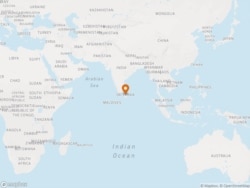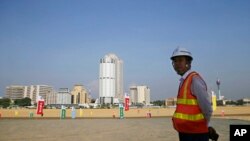From a new rail and road link that gives China overland access for the first time to the Indian Ocean via Myanmar to infrastructure projects in Sri Lanka’s east and north, concerns are running high in India as its rival, China, edges closer to its coast, analysts have told VOA.
While India has long confronted China along their rugged Himalayan borders, the maritime challenge is also growing as relations with its Asian neighbor have worsened.
Last month, Beijing transported a test cargo by road from Myanmar’s Yangon port on the Indian Ocean to the Chinese border province of Yunnan and by rail onto Chengdu in Sichuan province in southwestern China.
As the new trade route opened, China’s special envoy for Asian affairs Sun Guoxiang visited Myanmar for talks with its military rulers, who ousted the elected government of Aung San Suu Kyi in February.
Beijing, which has not condemned the army coup in Myanmar, is pressing ahead with bilateral projects that include a deep seaport in Myanmar’s Kyaukpyu along the Bay of Bengal.
It would be the third Chinese-developed port in India’s vicinity after Gwadar in Pakistan and Hambantota in Sri Lanka.
“Clearly they are coming closer and closer to India and that is extremely worrying given its adversarial, hostile relations with China,” said Rajeswari Pillai Rajagopalan, director for the Center for Security, Strategy and Technology at New Delhi’s Observer Research Foundation.
“Although these are civil projects, the overall worry is that these countries are falling more and more into Chinese influence,” he told VOA.
China has been building infrastructure projects in Sri Lanka and Myanmar — countries that provide access to the Indian Ocean, the vital sea lanes that ferry Beijing’s oil imports and carry its exports to the Africa, Middle East and Europe.

In Sri Lanka, India’s latest worries center on the Colombo Port City project being built by a Chinese state-owned firm adjacent to the strategic Colombo Port, just 300 kilometers from India. Those concerns intensified after the island country passed controversial legislation in May that critics say will give China virtual control over the approximately 62-hectare reclaimed land that is to be developed as a special economic zone.
Colombo hopes the Chinese development will turn into a financial hub between Singapore and Dubai, create hundreds of jobs and boost its struggling economy.
Sri Lankan geopolitics and foreign policy analyst Asanga Abeyagoonasekera described it to VOA as a “strategic trap.”
“Once you give these on a 99-year-lease, what kind of hold does the Sri Lankan government maintain? The danger is the that these could easily be turned into Chinese colonies or Chinese zones of activity,” he said.
“The hybrid nature of Chinese projects such as the 5G network is a question everywhere in the world,” he said, noting that there are suspicions of expansion of Chinese projects beyond their initial purpose. And that, he added, “represents a serious security threat.”
A $12 million renewable energy project awarded to a Chinese firm to be built on Sri Lankan islands off the northern Jaffna peninsula that lie barely 50 kilometers from India’s coast earlier this year is also causing concern in New Delhi.
While Beijing’s presence has loomed in big infrastructure projects in Sri Lanka such as the Hambantota port, an airport and highways for years, the Chinese footprint has grown since the return to power of President Gotabaya Rajapaksa and Prime Minister Mahinda Rajapaksa – the brothers have long been friendly to China.
“The leaders in Sri Lanka have amplified the pro-China tilt that began during their previous term,” according to Abeyagoonasekera.
Although built as trade routes as part of China’s ambitious Belt and Road initiative, these projects give significant potential military advantages, analysts said.
“It is not simply about protecting their commerce. This is part of China’s broader expansionism and the Chinese vision is of dominating the high seas and being a great maritime power,” Sreeram Chaulia, dean of the School of International Affairs of O.P. Jindal University, said.
Deepening distrust about Beijing in New Delhi following last year’s bruising, nine-month standoff along their Himalayan borders has made India more alert to the maritime threat it faces as it feels increasingly squeezed in the Indian Ocean, analysts say.
It is pushing back by accelerating its naval engagement with other countries also seeking to counter China. Once hesitant, India has now embraced the Quad, the informal alliance of India, the United States, Japan and Australia.
“India will need to step up its own naval capabilities but even if you make the investments today, developing these takes a very long time. So, India is building up its diplomatic muscle by increasing naval partnerships with countries,” Rajagopalan said.
Most recently those efforts were demonstrated during a visit last week to New Delhi by the Australian defense and foreign ministers.
Stating that both countries are working to enhance Australia’s “posture” in the Indian Ocean region, Australian Defense Minister Peter Sutton said that “It is in the sovereign interests of us both to align our strategy, our capability and our resources.”
Since last month, four Indian warships have also been engaged in exercises and port visits with the Philippines, Vietnam, Singapore, Indonesia and Australia in the Indo-Pacific.
However, analysts say despite efforts, India and its allies like Japan have been less successful in helping countries in the South Asian region develop the infrastructure for which they have turned to China.
“They need to do more on this front,” Chaulia said, adding, “If we wait for another five or 10 years, then China would already be in all the prime spots in this littoral region.”








